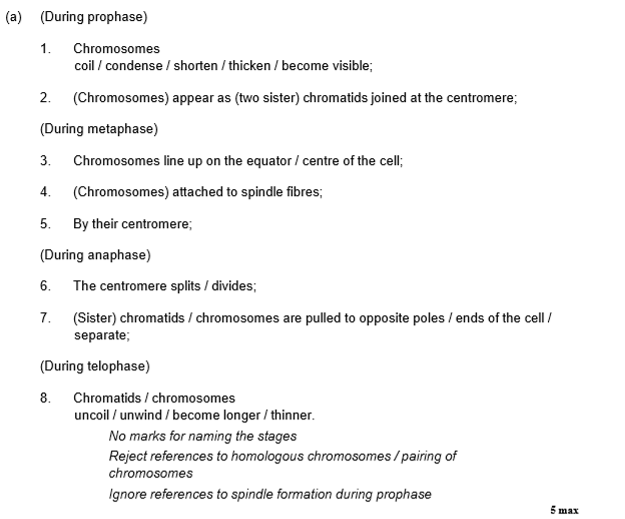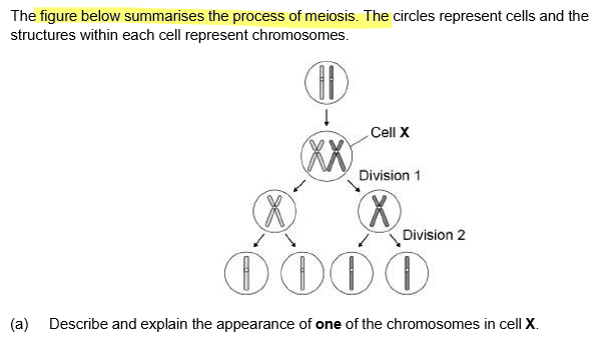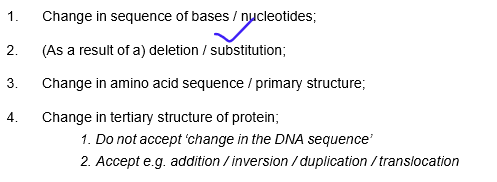Genetic diversity
1/7
There's no tags or description
Looks like no tags are added yet.
Name | Mastery | Learn | Test | Matching | Spaced |
|---|
No study sessions yet.
8 Terms






Continuation form question before


Meosis
Perfect — let’s go through meiosis step-by-step the way AQA A-level Biology expects you to understand it, clearly and simply so it sticks.
🔹 Overview
Purpose of meiosis:
To produce gametes (sex cells) with half the chromosome number (haploid, n) from a diploid (2n) parent cell.
So humans: 46 → 23 chromosomes.
Two divisions:
Meiosis I – reduction division (diploid → haploid)
Meiosis II – like mitosis (sister chromatids separate)
🧬 Meiosis I — Reduction Division 1⃣ Prophase I
Most important stage!
Chromosomes condense and become visible.
Homologous chromosomes (same genes, different alleles) pair up → bivalent formation.
Crossing over occurs:
Non-sister chromatids exchange alleles.
Produces new combinations of alleles → genetic variation.
Nuclear envelope breaks down and spindle fibres form.
✅ Key AQA word: “Crossing over between homologous chromosomes leads to genetic recombination.”
2⃣ Metaphase I
Homologous pairs line up side by side along the equator of the cell.
Independent assortment: orientation of each pair is random.
This means maternal and paternal chromosomes can go to either pole → variation.
✅ Key idea: “Random assortment of homologous chromosomes” = independent segregation.
3⃣ Anaphase I
Homologous chromosomes are pulled to opposite poles by spindle fibres.
Centromeres don’t split (sister chromatids stay together).
✅ Chromosome number halves — reduction division happens here.
4⃣ Telophase I
Nuclear envelope reforms around each set of chromosomes.
Cytokinesis (cell divides) → two haploid cells (but each chromosome still has two chromatids).
🧬 Meiosis II — Like Mitosis
No DNA replication before this division.
5⃣ Prophase II
New spindle apparatus forms in each haploid cell.
Chromosomes condense again (if they had decondensed).
6⃣ Metaphase II
Individual chromosomes line up along the equator.
Each chromosome’s sister chromatids attach to spindle fibres from opposite poles.
7⃣ Anaphase II
Centromeres divide, and sister chromatids separate.
Chromatids are pulled to opposite poles.
8⃣ Telophase II
Nuclear envelopes reform, and cytokinesis occurs.
Results in four genetically different haploid cells.
🌟 Summary Table
Stage | Key events | Chromosome state |
|---|---|---|
Prophase I | Crossing over, bivalents form | 2n |
Metaphase I | Homologous pairs line up randomly | 2n |
Anaphase I | Homologous chromosomes separate | n |
Telophase I | Two haploid cells form | n |
Prophase II | Spindle reforms | n |
Metaphase II | Chromosomes align singly | n |
Anaphase II | Chromatids separate | n |
Telophase II | Four haploid gametes | n |
🧠 AQA Exam Tips
Always say “alleles” when describing variation (not “genes”).
Write “crossing over → recombination of alleles”.
Write “independent segregation → different combinations of maternal and paternal chromosomes.”
Remember: meiosis → haploid and genetically different cells.
Would you like me to give you a simple labelled diagram of the stages to visualise it (AQA-style, simplified for revision)?






